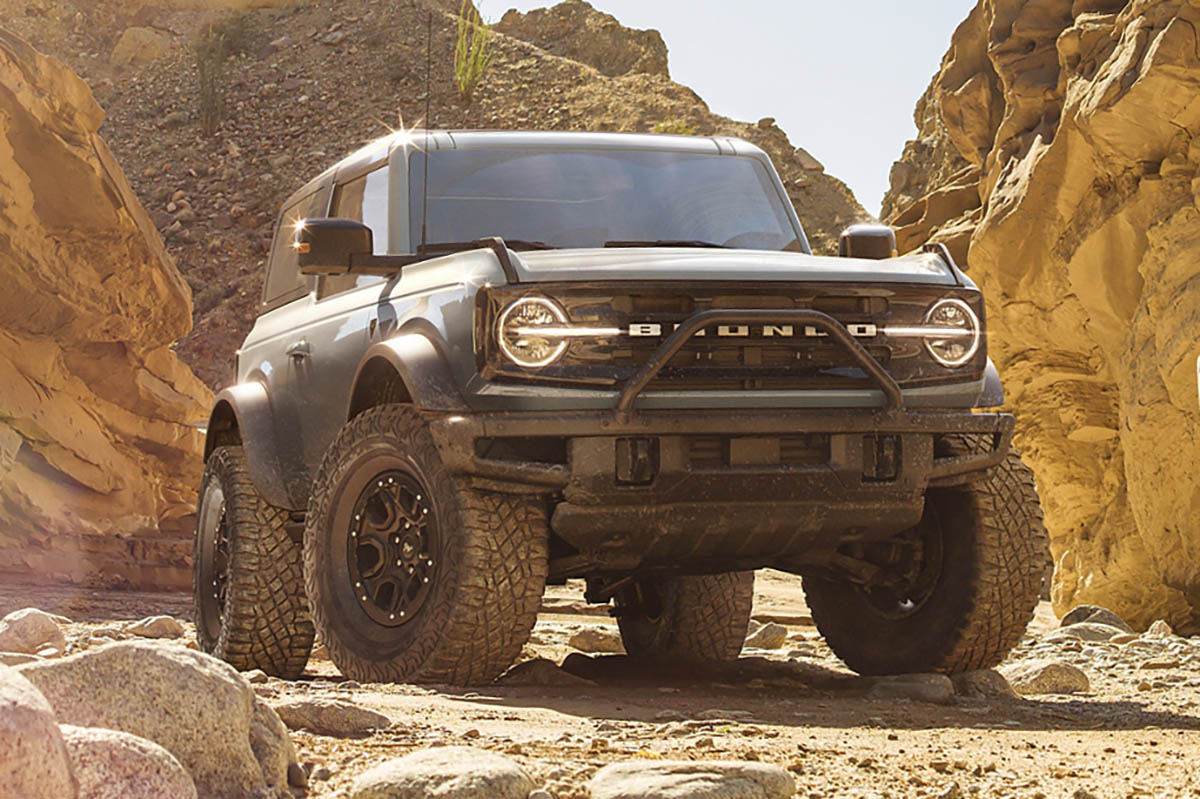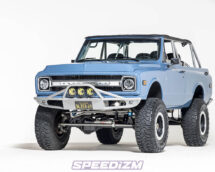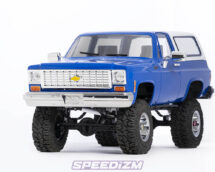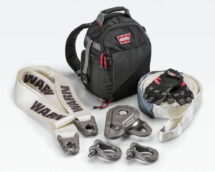Ford’s Reborn SUV Takes On The King of 4x4s
With the unveiling of the 2021 Ford Bronco in June of this year, the US extreme off-road market, abandoned by everyone but Jeep decades ago, finally got some real competition once more. Even without any direct rival to the Wrangler line, Jeep has clung tenaciously to their go-anywhere street cred by keeping each new generation true to its roots while adding more of the creature comforts and high-tech features buyers have come to expect from modern vehicles. Though today’s JL platform is a far cry from the original civilian CJ2, until the new Bronco gets into the hands of customers some time next year, it’s still the most sharply focused 4×4 you can buy straight off the showroom floor.

Meanwhile, Ford hasn’t exactly been ignoring the off-road market; the introduction of the first-gen SVT Raptor pickup for the 2010 model year signaled their intention to capture their share of the pie. It’s clear that the success of that model gave Blue Oval management the confidence not just to bring back the Bronco, but to position it in direct competition to one of the most iconic vehicles ever created. Knowing that simply recycling a beloved model name without the hardware to back it up was a plan doomed to failure (we’re looking at you, Chevy Blazer), they went all-in on matching or beating the Wrangler in every significant category.

Both Ford and Jeep have deep-rooted brand enthusiasts, so the question of whether potential buyers with strong feelings about either manufacturer will cross-shop between the Bronco and Wrangler is a complicated one. Loyalties aside, how do these two stack up, and what differences do they offer to someone looking for a competent, modern go-anywhere vehicle?
A Wealth of Choices
One thing potential buyers of either brand will have to contend with is the huge variety of different trim levels and equipment packages both Ford and Jeep bring to the table. Besides the simple choice between two and four doors, Wrangler buyers also have to decide between Sport, Sport S, Sahara (four door only) and Rubicon sub-models. Not to be outdone, Ford has saddled the Bronco line with no fewer than seven different equipment levels: Base, Big Bend, Black Diamond, Outer Banks, Wildtrak, Badlands, and Bronco First Edition. Then, there’s the additional “SasquatchTM” (yes, they actually trademarked that name) package, which is available on all but the Base model and Outer Banks Bronco.

Ford is unique among US manufacturers in ignoring the time-honored tradition of only giving one animal name per vehicle; while the idea of a “Mustang Cobra” is so ingrained in our collective consciousness that we don’t even think about how weird the idea of a horse snake is, we’d all scratch our heads at a Viper Appaloosa or an Impala Komodo Dragon. Nevertheless, there will be a Bronco Black Diamond Sasquatch, conjuring up the mental image of the Pacific Northwest’s beloved cryptid astride a bucking horse snowboarding down a challenging, ungroomed ski trail.

To get back on topic, though, both Jeep and Ford have gone to the effort of bundling up options in a panoply of combinations, the better to upsell high-margin content like upgraded interiors, electronics, unique cosmetic accents, and wheel-and-tire packages. Rather than doing Jeep and Ford’s marketing departments’ jobs for them by going into excruciating detail about each package on the Wrangler and Bronco, we’re going to take a step back and look at the general traits buyers in the market for these vehicles prioritize; power, off-road capability, customization potential, and of course value-for-money.

Personalized Potential
The off-road segment has always had a strong modification culture, from simple changes like wheels and tires to lifts, rock armor, winches, lights, and a thousand other ways for owners to put their own stamp on their truck or SUV. The JL Wrangler is certainly no exception to this phenomenon, and with a few years’ head start on the Bronco, there are already countless ways to customize a new Wrangler.

Of course, the team behind the 2021 Bronco was well aware of this, and made sure that the aftermarket would be able to hit the ground running when the model launched by letting key players have a sneak peek before the public reveal. Ford touts “more than 200 factory-backed aftermarket accessories” available at launch – certainly, quite a few of these will be in the floormats-and-seatcovers category, but you can bet that there will be plenty of more substantial add-ons ready to roll right into your new Bronco’s financing package. If the introduction of the Raptor models taught us anything, though, it’s that serious players will be quick to develop all manner of upgrades for the new SUV. It may take a while to rival the sheer variety of Wrangler parts out there, but they will definitely come. It will certainly help when off-lease Broncos start appearing on the secondary market, and as the initial 2021s reach the end of warranty coverage, another new group of potential customers will start looking for ways to update their Fords.

Where The Road Ends
Despite all the derision heaped upon Jeep owners who don’t actually leave the pavement with terms like “mall crawler,” “soft-roader,” and “hard parking,” the Wrangler has always been the benchmark for real off-road capability. The JL is no exception, and it’s interesting to see how closely the Bronco’s designers followed Jeep’s pattern, and where they diverged.

Both are built on traditional ladder frames, rather than unibody construction, and wheelbase and overall length are very similar – the 2-door Bronco is slightly longer hub-to-hub and bumper-to-bumper than its Wrangler counterpart, while the 4-door model has a marginally shorter wheelbase than the Jeep, though both are almost identical in overall length. The approach, breakover, and departure angles all favor the Jeep by a small margin in both chassis lengths when both SUVs are on tires of similar diameter, and the Jeep carries an advantage in ground clearance as well, though the Bronco is no slouch in this department either.

Where the two significantly depart from one another in suspension design is the front axle. Both Ford and Jeep roll on solid rear axles with coil-spring multi-link suspensions, but the Bronco has a twin-A-arm independent front suspension, while the Jeep maintains a tried-and-true solid front axle with coils and a leading-link suspension. Off-roaders will endlessly bench-race over the strengths and drawbacks of IFS versus a solid axle; suffice it to say here that if hardcore Jeep enthusiasts lost their minds over a switch from leaf springs to coils and round headlights to square, the day an independent-front Wranger is announced will make that look like a peaceful stroll through a Zen garden by comparison.

The 2021 Bronco will come standard with a part-time 4WD transfer case with a proper low range of 2.72:1, and there’s an optional on-demand box with an even lower 3.06:1 reduction. Jeep, always on top of snappy names for its various 4WD systems, offers the part-time Command-Trac TC with a 2.72:1 low range as standard kit, the full-time-capable Selec-Trac with the same ratio as an option, and the Rock-Trac with available full time 4WD and a 4:1 step-down at the top of the heap. Both Ford and Jeep come standard with open diffs at both ends; in the Wrangler you can step up to either a rear LSD or front and rear electronic lockers, while in the Bronco only the electronic diffs are available as a factory option.
Under The Hood
The Jeep JL, which debuted as a 2018 model year vehicle, comes standard for 2021 with the corporate Pentastar 3.6l V6, a mildly-reworked carryover from the previous JK models. In various states of tune, this engine also finds its way into a number of other FCA crossovers and SUVs; as presented in the Wrangler, it’s rated at 285 horsepower and 260 pound-feet of torque, and when paired with the optional eight-speed automatic transmission, it gets “mild hybrid” technology in addition to the engine start/stop fuel economy strategy the six-speed manual version has. For MPG-seeking buyers, a 2.0l turbo four is optional, offering 270 horses and 295 pound feet, and four-door Wranglers are available with something that’s been on many Jeep enthusiasts’ wish lists for a long time – a diesel engine option. The EcoDiesel V6, sourced from the Ram 1500, displaces 3 liters and provides 260 horsepower and a whopping 442 pound-feet of torque at the crank.

While none of these powerplants have the same legendary reputation for bucket-of-rocks reliability as Jeep’s dearly-departed straight-six, they’ve all been relatively trouble-free so far and should perform more or less as one would expect from their specifications. With that said, the aftermarket for power-enhancing upgrades for all of Chrysler’s recent vehicles has been hamstrung by the company’s efforts to keep engine control electronics locked down.
For the upcoming Bronco, Ford is only offering two engine choices at launch: The standard-equipment 2.3l turbocharged EcoBoost inline-four, and the optional 2.7l EcoBoost turbo V6. Both engines are more or less straight out of the corporate parts bin – decades ago, Ford decided that the future of internal combustion was mechanically-sophisticated small-displacement engines that used a lot of revs (and later, forced induction) as a substitute for displacement. While this made a lot of sense for passenger cars, it was less well-suited to light trucks and SUVs, and many brand-loyal Ford owners lamented the lack of grunty, big-cube naturally aspirated engines in the lineup. A lot has been written about how great it would be to have a Bronco powered by some version of the 5.0l Coyote V8 family, but it appears that at least for the time being, Ford wants you to stop worrying and learn to love the turbocharger.

And there’s plenty to love about the two EcoBoost engines currently available for the Bronco: The inline four squeezes an estimated 270 horsepower and 310 pound-feet out of its 2.3 liters, and the diminutive 2.7 liter V6 is projected to produce 310 and 400 respectively. While no diesel is offered, there’s a long shot that the EcoBlue 2.0l turbodiesel from the Transit and the overseas-only-for-now Ranger Raptor might power future model years, depending on how successful Jeep’s diesel option proves to be.
From the enthusiast’s standpoint, though, the takeaway for the two EcoBoost engines is that there is already a robust aftermarket for both the I4 and V6 – we’re going to give the edge in this category to the Bronco simply because Ford hasn’t been actively thwarting aftermarket tuning and engine upgrades in the way FCA has.
Sticker Shock
Finally, we get to the bottom line. A plain-vanilla 2021 Wrangler Sport 2-door carries an MSRP of $28,315, while adding an additional pair of doors will theoretically set you back a total of $31,815. Base Bronco pricing starts at $29,995 and $34,695 respectively. Once you start moving up through the various packages and adding options, trying to do an apples-to-apples comparison becomes hopelessly complicated. Typically, first-year models of any new vehicle that’s even remotely interesting tend to carry substantial markups due to high demand, once everything works its way through the byzantine dealer sales network system. The Bronco will undoubtedly follow this pattern as well, though Ford is accepting deposits for future delivery deep into 2022 for some packages.

Of course, the Wrangler has also maintained high buyer interest despite not being brand-spanking-new, so potential owners are faced with either a long wait for a build that matches their budget and priorities, or a long search through what’s in stock nationwide, which tends to skew heavily toward the optioned-to-the-gills models favored by dealers who want to squeeze maximum profit out of each unit they move. Though the pricing dynamics for the Wrangler and Bronco are somewhat different, the end result is probably as Ford intended; price parity for similarly specced vehicles.
FCA makes a big deal out of the whole, “it’s a Jeep thing – you wouldn’t understand” culture the Wrangler plays into, and it will be interesting to see if the same sort of community grows up around the new Bronco as well. Considering how well Ford has cultivated loyal buyers for Mustangs, F-150 pickups in general, and Raptor models in particular over the years, it’s very likely they will be able to work the same magic with their newest ‘nostalgia’ nameplate as well.









